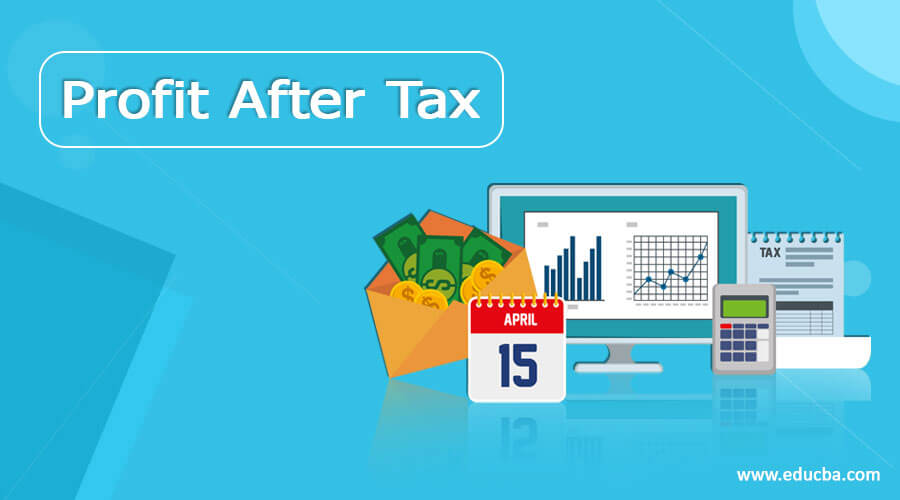Updated July 12, 2023
Definition of Profit after tax
Profit after tax refers to the net earnings of the company available for distribution to the shareholders or the owners after the deduction of all the expenses, including operating as well as non-operating expenses, interest costs, and the current year taxes from the total business income or we can say after deducting of tax expenses from the profit of the business before tax (PBT), we get the figure of Profit after tax (PAT).
Explanation
Taxes refer to the amount of money paid by the business entities on the net income earned by them. When the company deducts non-operating, operating, and interest expenses from the sum of operating income, interest income& other income of the business, the figure that arrives is known as profit before taxes (PBT). To calculate the Profit after tax (PAT), tax expense deduct from the profit before taxes (PBT). The figure of PAT considers the best measure to analyze the ability of the business to generate profits.
The Formula for Profit After Tax
The formula for PAT is:
Where Profit before tax is the earnings of the company after deducting all the expenses, including interest expense from the company’s total revenue (operating & non-operating both), And tax rate is the prevailing income tax rates in the country as per the income tax authorities.
How to Calculate Profit After Tax?
The PAT calculates by deducting the income taxes from the profit before taxes of the business.
Step-by-step calculation of computation of PAT:
- Step 1: Calculation of Profit before taxes: PAT is the figure on which the income tax rate applies, so the PAT is the taxable amount. Profit before taxes calculates by deducting operating expenses & non-operating expenses from the sum of total operating & non-operating income.
- Step 2: Determining tax percentage and Calculation of Tax amount: This tax percentage applicable to the company as per the income tax authorities is to determine. After that, we get the tax figure when we apply the tax rate percentage on the taxable amount, i.e., on the after-tax profit amount. In case of losses, the tax is not applicable, as the taxes will be paid if the company earns the profits. Therefore in such a case, losses after tax and the losses before tax are the same.
- Step 3: Calculation of PAT: In the third step, the tax amount calculated in Step 2 is deducted from the profit before taxes calculated in Step 1 to derive the PAT earned by the company during the period.
Example of Profit After Tax
Suppose a company, ABC Inc.’s total turnover during the previous financial year was $20,000. Following are the additional details:
- Interest income earned on fixed deposits: $2,000.
- The total operating expenses: $5,000
- Interest on loan: $1,000.
The tax rate of the company is 30%. Calculate the PAT.
Solution:
Calculation of Profit after tax
| Particulars | Amount ($) |
| Turnover | 20,000 |
| Add: Interest Income | 2,000 |
| Total Income [A] | 22,000 |
| Operating Expenses | 5,000 |
| Interest Income | 1,000 |
| Total Expenses [B] | 6,000 |
| Profit before tax [A-B] [C] | 16,000 |
| Tax Rate @30 % [D] | 4,800 |
| PAT [C-D] | 11,200 |
Therefore, the PAT of the company during the previous financial year was $11,200. This is generally available for distribution to the company’s shareholders.
Profit After Tax in Balance Sheet
When the company makes profits during any period, then each year, they are stimulated from its statement of profit and loss into its balance sheet. The balance sheet reflects retained earnings in the “Reserve and Surplus” head under the equity section. Thus, the amount of PAT is reported in the company’s balance sheet as retained earnings for the period.
Advantages
The advantages of PAT are as follows:
- The amount of PAT helps to know the profitability position of the business after paying off all the expenses, including tax expenses.
- The higher the amount of PAT, the higher the efficiency of the business to earn profits. A lower amount of PAT indicates low or average profit-earning efficiency.
- The amount of PAT determines the earnings available for the shareholders to be distributed as dividends. The higher the profit, the higher the dividend yield.
- The share price of the business also fluctuates according to the PAT. A higher amount of PAT results in a high stock price.
- Higher PATof the company fetches more investors as the company earning higher profits after taxes can be easily relied upon by the investors regarding returns that can be earned from the amount invested.
Disadvantages
The disadvantages of PAT are as follows:
- The concept of PAT is not applicable in the case of a company’s losses which means the business is not sustainable in continuous losses.
- When the tax rates are higher than it shows that the income tax burdens are more and the earnings available for the shareholders are very less.
- At times of inflation, when the operating expenses are higher, PAT gets reduced or may become negative, leaving the earnings available for the equity shareholders at zero.
Conclusion
Thus, PAT is the profit the business earns after deducting all the expenses (operating and non-operating) and the current year’s taxes as applicable. It is calculated by deducting tax expenses from the Profit before taxes. The higher the PAT of the company, the higher the company’s efficiency in earning profits.
Recommended Articles
This is a guide to Profit After Tax. Here we also discuss the definition and how to calculate profit after tax. Along with advantages and disadvantages. You may also have a look at the following articles to learn more –


